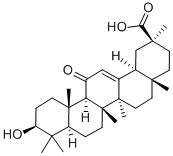Chemical Properties
Glycyrrhetinic acid is a kind of glycoside composed of glycyrrhizic acid-ff two molecules glucuronic acid. It appears as white crystalline powder with sweet taste. The sweetness is about 200 times of the sucrose. Its sweetness is different from other sweeteners such as sucrose. After eating, you can sense the sweetness only after a few moments but the retention time is long. Combination of a small amount of glycyrrhizin and sucrose can save 20% sucrose without affecting the sweetness. Although having no aroma, it has incense effect. It has a melting point (decomposition) of 220 ° C. The aqueous solution is weakly acidic and can be treated by acid.
Uses
Sweeteners; sweetness improving agents; flavor enhancers (dairy products, cocoa products, egg products, mutton), flavoring agents (function well especially when used in combination with salt), Chinese folk mostly use it in sauce and sauce products, pickled goods and so on.
Uses
18α-Glycyrrhetinic acid may be used to synthesize:
- 3-keto-18α-glycyrrhetinic acid
- methyl esters of 18α-glycyrrhetinic acid
- methyl esters of 3-keto-18α-glycyrrhetinic acid
General Description
18α-Glycyrrhetinic acid (18α-GA) is a bioactive triterpenoid found in licorice. It shows selective inhibition of 11-HSD1 (11-hydroxysteroid dehydrogenase 1). It also shows anti-proliferative and apoptotic effect on hepatic stellate cells (HSCs).




